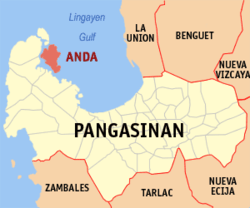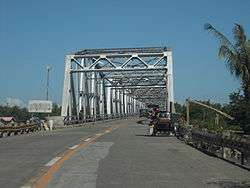Anda, Pangasinan
Anda, officially the Municipality of Anda (Pangasinan: Baley na Anda; Ilocano: Ili ti Anda; Tagalog: Bayan ng Anda), is a 3rd class municipality in the province of Pangasinan, Philippines. According to the 2015 census, it has a population of 39,504 people.[3] The people of Anda generally speak Pangasinan, Bolinao, and Ilocano.
Anda | |
|---|---|
| Municipality of Anda | |
 Anda Municipal Hall | |
 Seal | |
 Map of Pangasinan with Anda highlighted | |
OpenStreetMap 
| |
.svg.png) Anda Location within the Philippines | |
| Coordinates: 16°17′23″N 119°56′57″E | |
| Country | |
| Region | Ilocos Region (Region I) |
| Province | Pangasinan |
| District | 1st district |
| Founded | 1852 |
| Barangays | 18 (see Barangays) |
| Government | |
| • Type | Sangguniang Bayan |
| • Mayor | Joganie C. Rarang |
| • Vice Mayor | Artemio B. Carolino Jr. |
| • Congressman | Arnold D. Celeste |
| • Electorate | 23,235 voters (2016) |
| Area | |
| • Total | 74.55 km2 (28.78 sq mi) |
| Population (2015 census)[3] | |
| • Total | 39,504 |
| • Density | 530/km2 (1,400/sq mi) |
| • Households | 9,321 |
| Economy | |
| • Income class | 3rd municipal income class |
| • Poverty incidence | 11.52% (2015)[4] |
| • Revenue (₱) | 95,115,248.81 (2016) |
| Time zone | UTC+8 (PST) |
| ZIP code | 2405 |
| PSGC | |
| IDD : area code | +63 (0)75 |
| Climate type | tropical monsoon climate |
| Native languages | Bolinao Pangasinan Ilocano Tagalog |
| Website | www |
The municipality consists primarily of Cabarruyan Island (also known as Anda Island), as well as minor surrounding islets. Because of Anda's proximity near the Hundred Islands, a popular tourist destination for its caves and beaches, it is the so-called "Mother of the Hundred Islands."
Barangays

Anda is politically subdivided into 18 barangays.[5]
- Awile
- Awag
- Batiarao
- Cabungan
- Carot
- Dolaoan
- Imbo
- Macaleeng
- Macando-candong
- Mal-ong
- Namagbagan
- Poblacion
- Roxas
- Sablig
- San Jose
- Siapar
- Tondol
- Tori-tori
History
On the north-west portion of Lingayen Gulf lies a group of islands which comprise the territory of Anda.
Before the middle of the nineteenth century, the islands which comprise the municipality were uninhabited. Only occasionally did seafarers and fishermen use the coast as havens.
Andres de la Cruz Cacho, fondly called in Bolinao as Andales Kulayo, discovered a vast tract of land suitable for grazing and fertile lowlands, and an abundant spring for agriculture. It was he who brought families from the town of Bolinao aboard a big boat and dispersed them on the island of Cabarruyan in 1842. The spread of population was rapid.
On May 10, 1842, the pioneers landed on what is now the barrio of Dolaoan, put up a settlement, and chose San Miguel Arcangel as their Patron Saint. On May 25, 1842, they established Carot and Cabungan with Santa Lucia as the common Saint of the two settlements.
In the first of June of same year, Tondol was founded. Sablig was settled in the middle of June. By the third week of June, Macaleeng was occupied.
No family was willing, to stay in Toritori at the time and so the place was bypassed. The settlers proceeded to Awile and Aruab (now Roxas) and by early July, they have established settlements in the area.
By August, Mal-Ong, Awag, Santa Rita, and San Nicolas were established. Within a period of only four months, May to August, 1842, the whole island of Cabarruyan was populated.
A steady stream of settlers followed the first pioneers and soon within a few years, the population was large enough to form a municipality.
In January, 1849 a conference of leaders was called by Don Pablo Cacho Valerio through his son Don Domingo with the end in view to established a new town. The leaders drafted a petition for the creation of a new town and sent copies on March 15, 1849, to Don Jose Sanchez y Guerrero, the then Alcalde at Iba, Zambales and to the Archbishop of Manila.
On May 26, 1849, the Alcalde brought the reply granting the petition. Accompanied by the Parish Priest, Rev. Fr. Juan Migrano, Capitan Felipe Cacho Valerio, and other municipal officials of Bolinao, the Alcalde came to Cabarruyan to choose a suitable location for the town site. They agreed on Segat in the center of the island which is now known as Namagbagan. The site for the plaza, church, town hall, convent, cemetery, and streets were laid out on January 20, 1850, by order of the Alcalde.
Anda was once a part of the municipality of Bolinao.
Demographics
| Year | Pop. | ±% p.a. |
|---|---|---|
| 1903 | 3,916 | — |
| 1918 | 6,403 | +3.33% |
| 1939 | 8,989 | +1.63% |
| 1948 | 11,213 | +2.49% |
| 1960 | 14,580 | +2.21% |
| 1970 | 16,917 | +1.50% |
| 1975 | 19,262 | +2.64% |
| 1980 | 20,454 | +1.21% |
| 1990 | 26,856 | +2.76% |
| 1995 | 28,739 | +1.28% |
| 2000 | 32,833 | +2.90% |
| 2007 | 34,398 | +0.64% |
| 2010 | 37,011 | +2.70% |
| 2015 | 39,504 | +1.25% |
| Source: Philippine Statistics Authority[3][6][7][8] | ||
Climate
| Climate data for Anda, Pangasinan | |||||||||||||
|---|---|---|---|---|---|---|---|---|---|---|---|---|---|
| Month | Jan | Feb | Mar | Apr | May | Jun | Jul | Aug | Sep | Oct | Nov | Dec | Year |
| Average high °C (°F) | 31 (88) |
31 (88) |
31 (88) |
33 (91) |
32 (90) |
32 (90) |
30 (86) |
30 (86) |
30 (86) |
31 (88) |
31 (88) |
31 (88) |
31 (88) |
| Average low °C (°F) | 21 (70) |
21 (70) |
22 (72) |
24 (75) |
24 (75) |
24 (75) |
23 (73) |
23 (73) |
23 (73) |
23 (73) |
23 (73) |
22 (72) |
23 (73) |
| Average precipitation mm (inches) | 5.1 (0.20) |
11.6 (0.46) |
21.1 (0.83) |
27.7 (1.09) |
232.9 (9.17) |
350.8 (13.81) |
679.8 (26.76) |
733.1 (28.86) |
505 (19.9) |
176.6 (6.95) |
67.2 (2.65) |
17.7 (0.70) |
2,828.6 (111.38) |
| Average rainy days | 3 | 3 | 3 | 4 | 14 | 18 | 23 | 25 | 22 | 15 | 8 | 4 | 142 |
| Source: World Weather Online[9] | |||||||||||||
Transportation
The town is accessible through land transportation. Two main bus companies serve commuters to and from Anda to Manila or neighboring towns and cities. These are Dagupan Bus Co., Inc.and Pangasinan Five Star Bus Co. Mini buses and jeepneys are also available for commuters going to neighboring towns and cities, like Alaminos and Dagupan.
Economy
The town thrives on farming and deep-sea fishing.
In the past, progress in the town was sluggish due to its dependence to a landing barge to cross the Catubig Channel separating Anda to mainland Bolinao. In 1996, trade has increased due to a bridge connecting the municipality to the mainland. This bridge, known as Anda Bridge, was sponsored and inaugurated by then President Fidel V. Ramos, who hails from Pangasinan province. Main roads have been concreted for faster access to the barangays, especially tourism related places.
Fossil Finds
In the year 2000, fossils were found in barangay San Jose and barangay Awile. Fossils in barangay Awile were found only a few centimeters from the surface due to extensive erosion in the area. In San Jose, the fossils were discovered 3 meters from the ground surface. Most of the fossils were found in clay layer with limestone rubbles.
Among the faunal fossils discovered were from Stegodon sp., Elephas sp (large)., Elephas beyeri Von Koenigsvald (dwarf), Rhinoceros philippinensis, Cerpis sp. and Bovid sp.
See also
References
- "Municipality". Quezon City, Philippines: Department of the Interior and Local Government. Retrieved 31 May 2013.
- "Province: Pangasinan". PSGC Interactive. Quezon City, Philippines: Philippine Statistics Authority. Retrieved 12 November 2016.
- Census of Population (2015). "Region I (Ilocos Region)". Total Population by Province, City, Municipality and Barangay. PSA. Retrieved 20 June 2016.
- "PSA releases the 2015 Municipal and City Level Poverty Estimates". Quezon City, Philippines. Retrieved 1 January 2020.
- "Province: PANGASINAN". PSGC Interactive. Makati City, Philippines: National Statistical Coordination Board. Archived from the original on 14 November 2012. Retrieved 26 November 2012.
- Census of Population and Housing (2010). "Region I (Ilocos Region)". Total Population by Province, City, Municipality and Barangay. NSO. Retrieved 29 June 2016.
- Censuses of Population (1903–2007). "Region I (Ilocos Region)". Table 1. Population Enumerated in Various Censuses by Province/Highly Urbanized City: 1903 to 2007. NSO.
- "Province of Pangasinan". Municipality Population Data. Local Water Utilities Administration Research Division. Retrieved 17 December 2016.
- "Anda, Pangasinan: Average Temperatures and Rainfall". World Weather Online. Retrieved 23 September 2015.
External links
| Wikimedia Commons has media related to Anda, Pangasinan. |